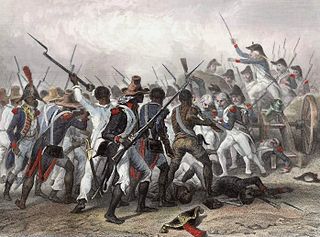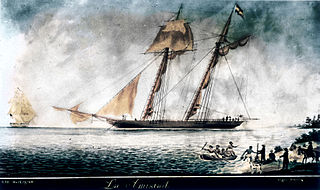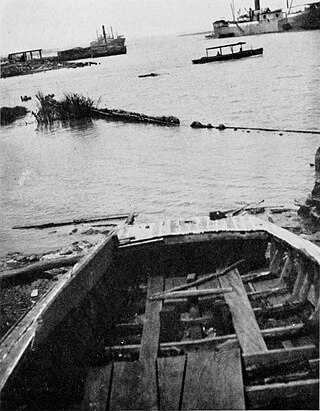
The Atlantic slave trade or transatlantic slave trade involved the transportation by slave traders of enslaved African people, mainly to the Americas. The outfitted European slave ships of the slave trade regularly used the triangular trade route and its Middle Passage, and existed from the 16th to the 19th centuries. The vast majority of those who were transported in the transatlantic slave trade were from Central and West Africa who had been sold by West African slave traders mainly to Portuguese, British, Spanish, Dutch, and French slave traders, while others had been captured directly by the slave traders in coastal raids; European slave traders gathered and imprisoned the enslaved at forts on the African coast and then brought them to the Americas. Except for the Portuguese, European slave traders generally did not participate in the raids because life expectancy for Europeans in sub-Saharan Africa was less than one year during the period of the slave trade.

United States v. Schooner Amistad, 40 U.S. 518 (1841), was a United States Supreme Court case resulting from the rebellion of Africans on board the Spanish schooner La Amistad in 1839. It was an unusual freedom suit that involved international diplomacy as well as United States law. The historian Samuel Eliot Morison described it in 1969 as the most important court case involving slavery before being eclipsed by that of Dred Scott v. Sandford in 1857.

The Middle Passage was the stage of the Atlantic slave trade in which millions of enslaved Africans were transported to the Americas as part of the triangular slave trade. Ships departed Europe for African markets with manufactured goods, which were then traded for slaves with rulers of African states and other African slave traders. Slave ships transported the slaves across the Atlantic. The proceeds from selling slaves were then used to buy products such as furs and hides, tobacco, sugar, rum, and raw materials, which would be transported back to Europe to complete the triangle.

Triangular trade or triangle trade is trade between three ports or regions. Triangular trade usually evolves when a region has export commodities that are not required in the region from which its major imports come. It has been used to offset trade imbalances between different regions.

Amistad is a 1997 American historical drama film directed by Steven Spielberg, based on the events in 1839 aboard the Spanish slave ship La Amistad, during which Mende tribesmen abducted for the slave trade managed to gain control of their captors' ship off the coast of Cuba, and the international legal battle that followed their capture by the Washington, a U.S. revenue cutter. The case was ultimately resolved by the U.S. Supreme Court in 1841.

Sengbe Pieh, also known as Joseph Cinqué or Cinquez and sometimes referred to mononymously as Cinqué, was a West African man of the Mende people who led a revolt of many Africans on the Spanish slave ship La Amistad in July 1839. After the ship was taken into custody by the US Revenue-Marine, Cinqué and his fellow Africans were eventually tried for mutiny and killing officers on the ship, in a case known as United States v. The Amistad. This reached the U.S. Supreme Court, where Cinqué and his fellow Africans were found to have rightfully defended themselves from being enslaved through the illegal Atlantic slave trade and were released. The US government did not provide any aid to the acquitted Mende People. The United Missionary Society, a black group founded by James W.C. Pennington, helped raise money for the return of thirty-five of the survivors to Sierra Leone in 1842.

Wanderer was the penultimate documented ship to bring an illegal cargo of enslaved people from Africa to the United States, landing at Jekyll Island, Georgia, on November 28, 1858. It was the last to carry a large cargo, arriving with some 400 people. Clotilda, which transported 110 people from Dahomey in 1860, is the last known ship to bring enslaved people from Africa to the US.

Slave ships were large cargo ships specially built or converted from the 17th to the 19th century for transporting slaves. Such ships were also known as "Guineamen" because the trade involved human trafficking to and from the Guinea coast in West Africa.

La Amistad was a 19th-century two-masted schooner owned by a Spaniard living in Cuba. It became renowned in July 1839 for a slave revolt by Mende captives who had been captured and sold to European slave traders and illegally transported by a Portuguese ship from West Africa to Cuba, in violation of European treaties against the Atlantic slave trade. Spanish plantation owners Don José Ruiz and Don Pedro Montes bought 53 captives in Havana, Cuba, including four children, and were transporting them on the ship to their plantations near Puerto Príncipe. The revolt began after the schooner's cook jokingly told the slaves that they were to be "killed, salted, and cooked." Sengbe Pieh unshackled himself and the others on the third day and started the revolt. They took control of the ship, killing the captain and the cook. Three Africans were also killed in the melee.
Pedro Blanco (1795–1854) was a notorious Spanish slave trader based in Gallinas on the coast of Sierra Leone between 1822 and 1838. Before entering the slave trade, Blanco ran a sugar mill in Cuba.

James Benjamin Covey was a sailor, remembered today chiefly for his role as interpreter during the legal proceedings in the United States federal courts that followed the 1839 revolt aboard the Spanish slave ship La Amistad. Covey, who spoke Mende and English, was instrumental for enabling the Mende passengers of the Amistad to communicate with the court and to defend themselves successfully against charges of mutiny and murder.
The Hannibal was a slave ship, hired by the Royal African Company of England. The ship participated in two slave trading voyages, in the Triangular Trade. The wooden sailing ship was 450 tons and mounted with thirty-six guns. The ship is most remembered for her disastrous voyage of 1693–95. Captain Thomas Phillips commanded the Hannibal. He was a Welsh sea captain from Brecon, Wales who was employed by the Sir Jeffrey Jeffreys, and others. who owned the Hannibal and were governors and Assistants in the Royal African Company.

The schooner Clotilda was the last known U.S. slave ship to bring captives from Africa to the United States, arriving at Mobile Bay, in autumn 1859 or on July 9, 1860, with 110 African men, women, and children. The ship was a two-masted schooner, 86 feet (26 m) long with a beam of 23 ft (7.0 m).
HMS Nimble was a Royal Navy 5-gun schooner-of-war. She was employed in anti-slave trade patrol from 1826 until 1834, when she was wrecked on a reef with the loss of 70 Africans who had been rescued from a slave ship.
Guerrero was a Spanish slave ship that wrecked in 1827 on a reef near the Florida Keys with 561 Africans aboard. Forty-one of the Africans drowned in the wreck. Guerrero had been engaged in a battle with a British anti-slavery patrol ship, HMS Nimble, stationed on the northern approaches to Cuba. Nimble also ran onto the reef, but was refloated and returned to service. The two ships were attended by wreckers, who rescued the Spanish crew and surviving Africans from their ship and helped refloat Nimble. Spanish crew members hijacked two of the wrecking vessels and took almost 400 Africans to Cuba, where they were sold as slaves. Most of the remaining Africans were eventually returned to Africa.

The Slave Route Project is a UNESCO initiative that was officially launched in 1994 in Ouidah, Benin. It is rooted in the mandate of the organization, which believes that ignorance or concealment of major historical events constitutes an obstacle to mutual understanding, reconciliation and cooperation among peoples. The project breaks the silence surrounding the slave trade and slavery that has affected all continents and caused great upheavals that have shaped our modern societies. In studying the causes, the modalities and the consequences of slavery and the slave trade, the project seeks to enhance the understanding of diverse histories and heritages stemming from this global tragedy.
Simeon Jocelyn was an American minister, abolitionist, and activist known for promoting educational opportunities and civil and political rights for African Americans in New Haven, Connecticut, during the 19th century. He is also known for his attempt to establish the United States' first college for African Americans in New Haven, and for his role in the Amistad affair.
Young Hero was launched at Liverpool in 1785. She made six complete voyages as a slave ship in the triangular trade in enslaved people. On her first and second voyages she sailed under an asiento, that permitted her owners to bring and sell captives in Spanish territories. She was seized and condemned in 1794 after having landed the captives from her seventh voyage.
Golden Age was launched at Havana in 1779, almost certainly under another name. She was taken in prize circa 1783. From late 1783 she sailed from Liverpool as a slave ship in the triangular trade in enslaved people. She made four complete voyages. On her third her captives rebelled, but were unsuccessful. A French private frigate captured her in 1793 after she had disembarked her captives from her fifth enslaving voyage. Her captors took her into Philadelphia where she was sold to a French owner who named her Republican, and sailed her to France.











